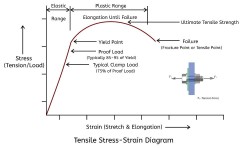
Ultimate tensile strength, often shortened to tensile strength (TS) or major force, is the maximum stress a material can withstand while being stretched or pulled before necking, ie when the specimen cross-section starts to significantly contract. Tensile strength is the opposite of compressive strength and values ??can be very different.
Tensile Strength is usually found by performing a tensile test and record the pressure on the highest point of the strain stress-strain curve is Tensile Strength. This is an intensive property, so the value is not dependent on the size of the test specimen. However, depending on other factors, such as specimen preparation, or the presence of surface defects, and the temperature of the test environment and material.
Tensile strength that is rarely used in the design of ductile members, but they are important in brittle members. They are tabulated for common materials such as alloys, composite materials, ceramics, plastics, and wood.
Tensile strength is defined as a pressure, which is measured as the force per unit area. For some non-homogeneous materials (or for assembled components) can be reported only as a power or as the force per unit width. In the SI system, the unit is the pascal (Pa) (or more often megapascals (MPa), using the prefix mega-), or, equivalently with pascal, newton per square meter (N / m²). His unit usually is pound-force per square inch (lbf / in ² or psi), or kilo-pounds per square inch (ksi, or sometimes KPSI), which is equal to 1000 psi, kilo-pounds per square inch are generally used for convenience when measuring tensile strength.
Concept
Ductile materials
Many materials featuring elastic behavior linear, defined by a stress-strain relationship linear, as shown in the figure to point 2, in which the deformation is completely restored after the removal of the load, ie, a specimen is loaded elastic in tension will stretch, but going back to its original shape and size when disassembled. This external linear, for ductile materials, such as steel, is plastic deformation.
A specimen of plastic deformation will not return to its original size and shape when unloaded. Note that there will be a partial elastic recovery of deformation. For many applications, the plastic deformation is unacceptable, and is used as a design limitation.
Tensile Strength is not used in the design of a static member ductile because of design practice dictates the use of the yield stress. This, however, is used for quality control, for ease of testing. It is also used to determine roughly the type of material for the unknown sample.
Brittle materials
Brittle materials, such as concrete and carbon fiber, which is characterized by a failure in a small strain. They often fail when they behave in a linear elastic manner, and thus does not have a defined yield point. Because the strain is low, there is negligible difference between the pressure of engineering and the correct pressure. Testing of several identical specimens will produce different voltage failure, this is due to the Weibull modulus of the material brittle.
Tensile Strength is a common engineering parameters when designing member fragile, because there is no yield point.
and a useful tool for measuring a tensile strength is the tensile strenght tester,
This instrument measures the maximum tensile strength of the test specimen shall stand before the break and elongation upon rupture. It is used to determine the tensile strength and reganganpada rest of the paper, board, metal foil, textiles and plastics .Elektro-mechanical (Motor Type Schopper) is an effective model for providing reliable and cost determination of tensile strength and starch paper, cardboard and similar materials more. Interest level is set via the DC variable speed drive during the test through calibrated ometer potential.




 Portable System
Portable System Integrated Online Monitoring
Integrated Online Monitoring Material Testing Machine
Material Testing Machine Vibration Sensor
Vibration Sensor Integrated Online Monitoring
Integrated Online Monitoring Portable System
Portable System Adhesive Testing
Adhesive Testing Boxes & Cartons
Boxes & Cartons Composite Films
Composite Films Films & Foils
Films & Foils Label
Label Alat Industri Sipil
Alat Industri Sipil Engine Industries
Engine Industries Food & Beverage Industries
Food & Beverage Industries Pharmacy Industries
Pharmacy Industries Paper Industries
Paper Industries Plastic Industries
Plastic Industries Power Industries
Power Industries Automotive Industries
Automotive Industries Electronic Industries
Electronic Industries Packaging Industries
Packaging Industries Manufacture Industries
Manufacture Industries Rubber Industries
Rubber Industries Oil and Gas Industries
Oil and Gas Industries Printing Testing Equipment
Printing Testing Equipment Jasa Kalibrasi Alat dan Mesin Jakarta
Jasa Kalibrasi Alat dan Mesin Jakarta NDT Portable System
NDT Portable System NDT Online Monitoring
NDT Online Monitoring Weather Station
Weather Station Data & Logger By Application
Data & Logger By Application Data & Logger By Performence
Data & Logger By Performence Data & Logger By HOBO
Data & Logger By HOBO Sensor Suhu
Sensor Suhu Sensor Jarak
Sensor Jarak Sensor Kecepatan
Sensor Kecepatan Sensor Tekanan
Sensor Tekanan Gaya Puntir
Gaya Puntir Gaya Tekan
Gaya Tekan Sensor Posisi
Sensor Posisi Sensor Optik
Sensor Optik Sensor Khusus
Sensor Khusus Sensor Warna
Sensor Warna Unit Pemrosesan Sinyal
Unit Pemrosesan Sinyal Pengukuran 2D/3D
Pengukuran 2D/3D Sensor Ketebalan
Sensor Ketebalan Sistem Inspeksi
Sistem Inspeksi









